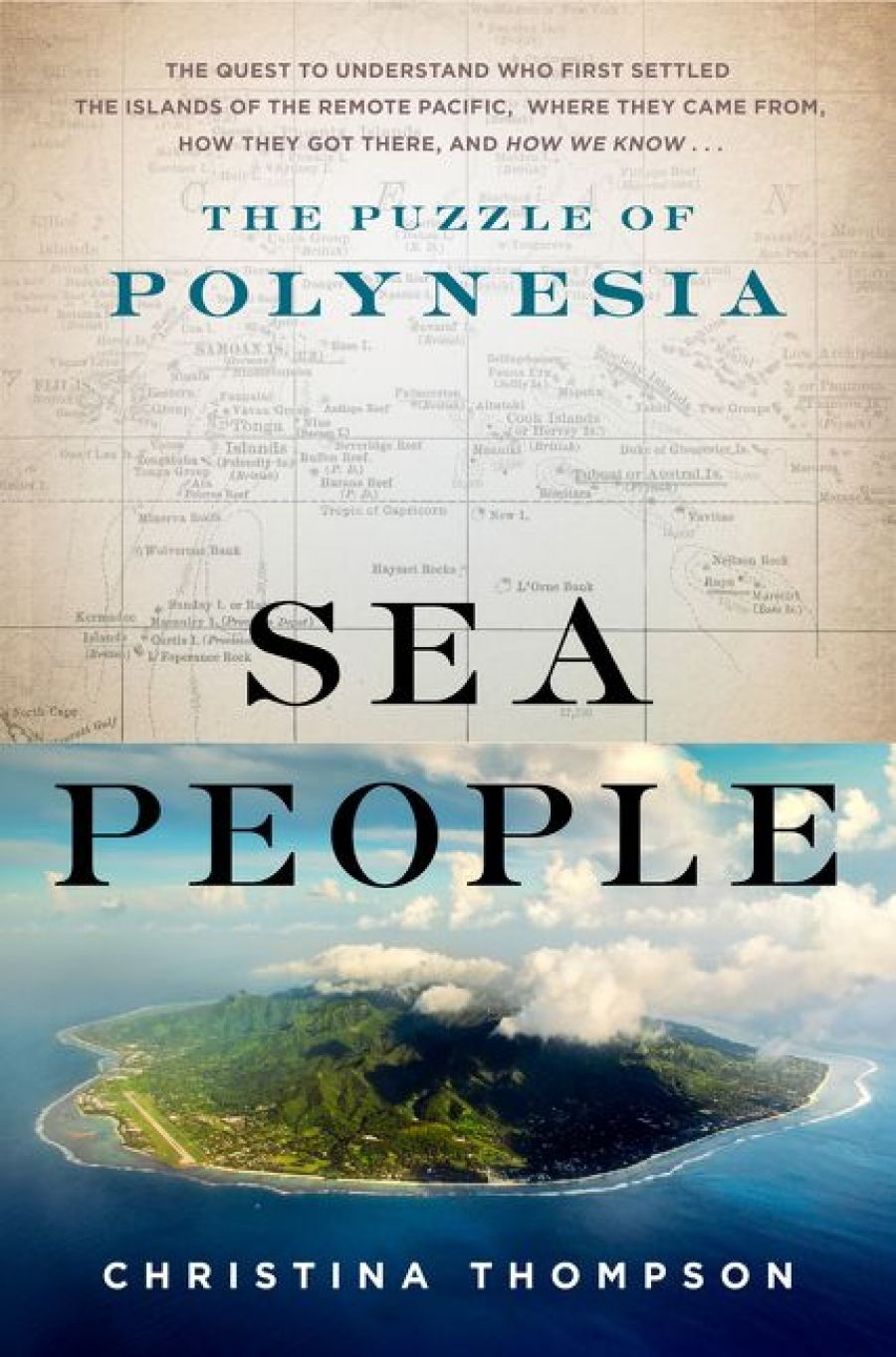
- Free Article: No
- Contents Category: History
- Custom Article Title: Ceridwen Spark reviews <em>Sea People: The puzzle of Polynesia</em> by Christina Thompson
- Review Article: Yes
- Online Only: No
- Custom Highlight Text:
When asked to review Sea People: The puzzle of Polynesia, I thought it might be hard work – improving, but not necessarily fun. I could not have been more wrong. The book is a triumph. Exploring the remarkable history of Polynesian migration to the ‘vast triangle stretching from Hawaii to New Zealand to Easter Island’, it is magnificently researched, assured, and elegant ...
- Book 1 Title: Sea People
- Book 1 Subtitle: The puzzle of Polynesia
- Book 1 Biblio: HarperCollins, $34.99 pb, 384 pp, 9780008339029
Thompson has authored many essays and much literary criticism, but her only other book is Come on Shore and We Will Kill and Eat You All: A New Zealand story (2008). Described as a mixture of ‘history and memoir’, Come on Shore was much lauded on release. In it, Thompson tells of meeting her husband, Seven, a Māori whom she first encountered in a pub in New Zealand’s Bay of Islands.
We meet Seven again, albeit briefly, in the prologue of Sea People. While the book ultimately tells us almost nothing about him or the couple’s three sons, the author’s desire to understand the people who made the Polynesian Triangle their home is clearly personal. She writes:
Seven … is descended from a voyager named Puhi, who sailed to New Zealand from the ancestral homeland of Hawaiki in one of a fleet of eight great canoes. … his ancestors came to Aotearoa (the Polynesian name for New Zealand) from an island in Eastern Polynesia and … their ancestors came to that island from another island before that. The simplicity of this genealogy is stunning. … For centuries Polynesians were the only people in this region of the world, and thus the only people Seven can be descended from are the ones who figured out how to cross thousands of miles of open ocean in double-hulled voyaging canoes.
Embodying Thompson’s ‘quest to understand who first settled the islands of the remote Pacific, where they came from, how they got there, and how we know’, Sea People thus constitutes a kind of love letter to Thompson’s husband and children and the places from which they come. It is an accomplished and authoritative missive.
 Richard Owen and a moa skeleton (c.1879)
Richard Owen and a moa skeleton (c.1879)
After the prologue, Sea People is chronological in structure. It commences with the explorer Ferdinand Magellan, relates some of the story of James Cook (who was killed by locals on his third voyage to Hawai’i, in 1779), examines various attempts (indigenous and otherwise) to account for the unlikely arrival of Polynesians in this vast expanse, and into the present-day understanding of the region as informed by ‘the latest science’, including DNA studies of Polynesian remains.
In this fascinating journey through time and space, Thompson displays an enviable command of her material, both the details and the big picture. Turning over an incredible array of ‘evidence’, anthropological, archaeological, geographical, and otherwise, she displays a keen eye for what each body of knowledge reveals about the puzzle of Polynesian migration. But, in her capable hands, we are never lost or overwhelmed. With short chapters and a great deal of command, she layers knowledge seamlessly, communicating her own intrigue and thereby keeping ours alive.
At the same time and without ever hitting us over the head with it, Thompson exposes the politics of knowledge, the way it is formed and by whom. It was fascinating to learn, for instance, about Māori anthropologist Te Rangi Hīroa’s resistance to the idea that his forebears came through Melanesia and were mingled with them genetically. As Thompson writes, in the ‘racially charged climate of the early twentieth century’, Te Rangi Hīroa was aware that the term ‘Melanesian’ had ‘long served in European discourse as a marker for otherness and inferiority … you can see him struggling with the problem’. Similarly, she tells us about the repercussions of the iconoclastic historian Andrew Sharp’s claim that Polynesian oral traditions were essentially of no use in determining their history of arrival, and his argument that they sailed into the region more by accident than design. While not quite launching a thousand ships, Sharp’s latter claim gave rise to multiple sea journeys designed to test Polynesian navigation. Proving once and for all that traditional navigational techniques not only worked but were based on a rich and different way of knowing, this series of adventures was as much political and anti-colonial as oceanic.
The most memorable aspect of Sea People arises from Thompson’s affection for and interest in her ‘characters’. We meet some amazing people, while learning details about some more familiar ones, including Cook and Joseph Banks. In the former vein, one stands out even among an impressive cast: Tupaia, a Tahitian who decided to join Captain Cook on his voyage merely days after meeting him and without any real idea of where the journey would lead. Arriving in New Zealand, Tupaia communicated with the locals, thereby enabling the British visitors to avoid the fate of their predecessors who had been chased away with a haka. His ability to do so also revealed, for the first time, the remarkable linguistic links across this vast region. Thompson’s fondness for Tupaia and the many others from whom she has learned about ‘the puzzle of Polynesia’ is infectious.
Infused with curiosity and respect, Sea People is everything historical non-fiction should be.


Comments powered by CComment